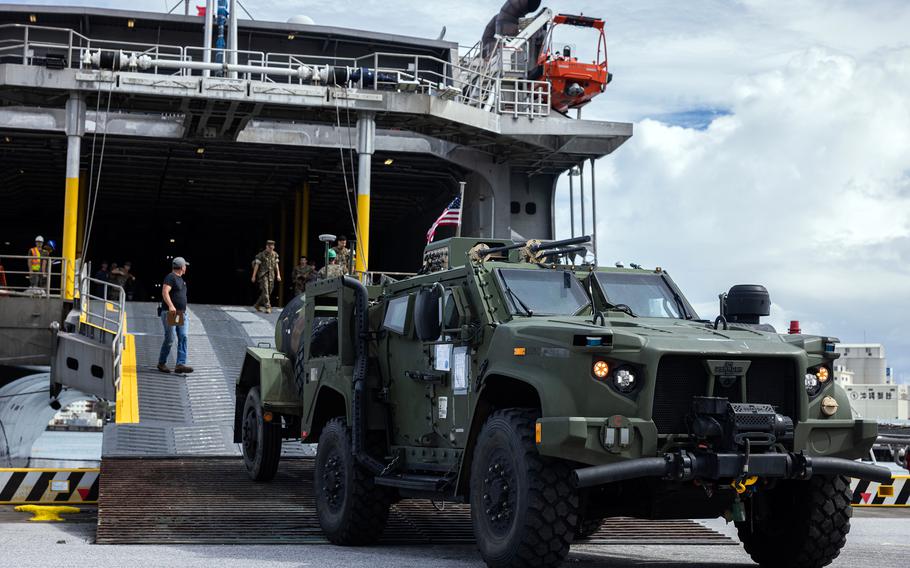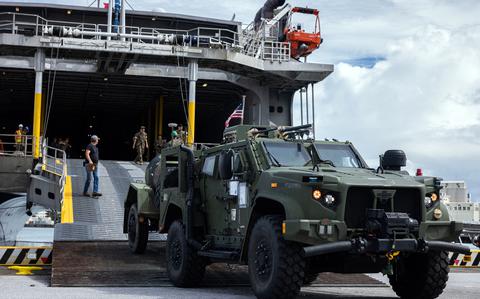
Members of the 3rd Marine Division unload a Navy-Marine Expeditionary Ship Interdiction System at Naha Military Port, Okinawa, July 10, 2025. (Rodney Frye/U.S. Marine Corps)
The Marine Corps will deploy two new missile systems to Japan’s Ishigaki Island for the first time during a joint exercise beginning this week, U.S. and Japanese military officials said.
The Navy-Marine Expeditionary Ship Interdiction System, or NMESIS, and the Marine Air Defense Integrated System, or MADIS, will be used during Resolute Dragon, annual drills running Thursday through Sept. 25 across Japan, III Marine Expeditionary Force said in a news release Friday.
At Camp Ishigaki, Marines will conduct joint anti-ship and anti-air combat training without live fire, according to a Japanese Ministry of Defense document posted Friday on the city’s website.
The missile systems will be deployed only to Ishigaki, a Ground Staff spokesman said by phone Tuesday. It will be their first time deployed on the island, he added.
The exercise, which includes command post and field training, will “rehearse bilateral crisis response and contingency operations,” the Marine release said.
The training comes as China steps up military and coast guard activity near Taiwan and around Japanese-held islands in the East China Sea. In June, China carried out its first Pacific drills involving both of its aircraft carriers, the Shandong and Liaoning. One carrier may have simulated a U.S. carrier in interception drills, The Japan News reported July 18.
Ishigaki lies about 150 miles east of Taiwan.
This year’s Resolute Dragon will be the largest ever, with about 5,200 U.S. and 14,000 Japanese troops participating, according to the Marines.
“By training alongside the Western Army in realistic, combat-focused scenarios, we sharpen the warfighting edge of our forces and present a clear, credible deterrent to any adversary who would threaten peace and security in the Indo-Pacific,” III MEF commander Lt. Gen. Roger Turner said in the release.
The drills’ growing scale reflects “the importance of this exercise and the desire of joint and allied forces to join in the opportunity to enhance our readiness,” spokesman 2nd Lt. James Selcke said by email Friday.
The Marines’ 3rd Littoral Regiment first deployed MADIS and NMESIS in April during the Balikatan exercise in the Philippines. The systems arrived on Okinawa in July, 1st Lt. Joshua Figueredo, a 3rd Marine Division spokesman, said by email Friday.
MADIS, armed with Stinger missiles, a 30 mm cannon and 7.62 mm machine gun, is designed to counter low-flying aircraft and armed drones. NMESIS mounts Naval Strike Missiles on joint light tactical vehicles to target ships at sea.
The systems are part of the Corps’ Force Design restructuring plan, which calls for littoral regiments to operate within range of enemy fire to seize and hold islands and block hostile vessels from nearby waters.
Separately, U.S. and Japanese troops plan to fire the Marines’ High Mobility Artillery Rocket System, or HIMARS, and Japan’s Multiple Launch Rocket System during the exercise, the Marine release said. The systems will be at Yausubetsu Maneuver Area on Hokkaido from Sept. 14-24, according to another Defense Ministry document posted on Betsukai town’s website.
Okinawa Defense Bureau officials told Yonaguni Mayor Tsuneo Uechi on Friday that HIMARS will not be deployed to Yonaguni, a spokesman said that day. The island — Japan’s westernmost territory — is about 80 miles closer to Taiwan than Ishigaki. Uechi had opposed the possible deployment, which was reported earlier in Japanese media.
Some Japanese government officials must speak to the press on condition of anonymity.
Stars and Stripes reporter Hana Kusumoto contributed to this report.


AloJapan.com